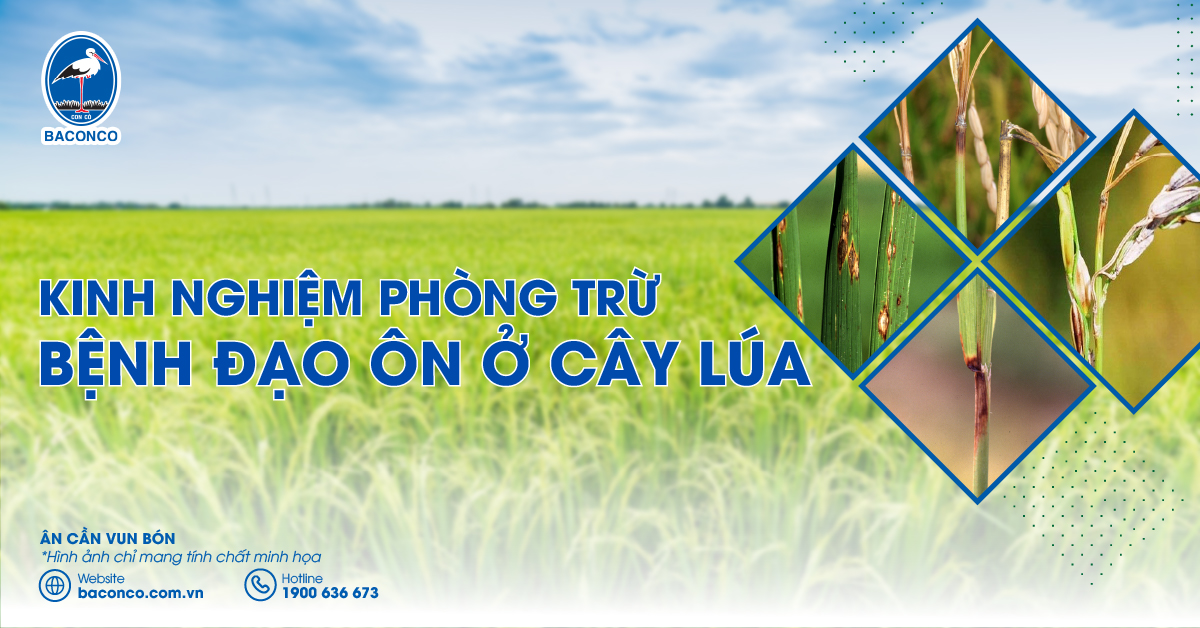Experience In Treatment And Prevention Rice Blast Disease
30 Jul 2024

If not detected and controlled in time, rice blast disease can severely damage rice yield. In this article, we will join Baconco to learn about this disease and effective ways to manage and prevent it.
Signs of rice blast disease in rice plants
The symptoms of rice blast disease are most apparent on leaves, panicle necks, nodes, and grains:
- On leaves: Small, light grayish-green spots appear. These spots gradually enlarge into spindle-shaped lesions with a grayish center, surrounded by dark brown borders and a light brown outer edge. If not treated promptly, these lesions can coalesce, causing the leaves to dry out and burn.
- On nodes: Brown lesions encircle the nodes, causing them to dry out, shrink, and rot, leading to the plant's collapse.
- On panicle necks: Initially, a small black spot appears at the neck adjacent to the leaf sheath. Over time, this spot enlarges, causing the panicle neck to wither, leading to white or partially filled grains.
- On grains: The fungus develops on the husk and may penetrate the grain, forming irregular grayish-brown lesions.
Rice blast disease lesions appear on the leaves
Causes of rice blast disease
Rice blast is caused by the fungus Pyricularia oryzae Carava. Typically, the fungus exists on plant debris, weeds, etc., in the form of mycelium and spores. Under favorable weather conditions, the fungus invades rice plants and spreads the disease through the wind.
Pyricularia oryzae Carava secretes picolinic acid and pyricularin, which inhibit respiration and decompose enzymes, making it difficult for severely infected plants to recover.
Rice blast disease is influenced by several external factors:
- Weather conditions: The disease thrives and causes significant damage under cool, light wind, high humidity, large temperature differences between day and night, and prolonged frequent rain.
- Nutritional conditions: An imbalance between nitrogen, phosphorus, and potassium often promotes the development of rice blast (fields with excess nitrogen are more susceptible).
- Rice varieties: Infected seeds may unknowingly be used for planting, increasing the risk of the disease. Although many resistant varieties are available in Viet Nam, their disease resistance is still affected by weather conditions, soil, and cultivation techniques.
- Disease sources: The fungus persists in straw, weeds, seeds, etc., and spreads to subsequent crops. Additionally, fungal spores can easily disperse in the air and cause outbreaks under suitable conditions.
Frequent, prolonged rain and high humidity increase the possibility of rice blast disease
Consequences of rice blast disease
Rice blast can result in severe consequences, such as:
- Reduced yield and quality: The disease causes leaf burn, stem collapse, and stunted growth, leading to unfilled or partially filled grains, significantly reducing yield. If not detected early and treated promptly, the disease can cause complete yield loss.
- Impact on farmers' income: Reduced yield due to rice blast lowers farmers' income, affecting their livelihood.
- Increased production costs: Farmers need to use more fungicides and fertilizers to combat the disease, leading to higher production costs.
- Impact on the rice market: Reduced rice production due to rice blast leads to price fluctuations, affecting both domestic and international markets.
Rice blast disease seriously affects the growth and development of rice plants
Methods to manage rice blast disease
The fungus Pyricularia oryzae Carava can develop rapidly and cause widespread damage. Therefore, upon detecting the disease, special attention is needed:
- Stop all fertilization and adjust water levels according to the rice plant's needs, avoiding drought.
- Use CO-TRICY specifically for rice blast as follows:
- Dosage: 18 grams per 25 liters (spray 2 tanks per 1,000 m²).
- For panicle neck blast: When the field begins to head, apply the spray as follows: First spray: 7 days before heading, Second spray: 7 days after heading.
- After spraying, ensure the disease has stopped progressing (new leaves are not infected) before resuming fertilization. Adjust the plant's nutrition by reducing nitrogen and enhancing potassium to strengthen the plant and increase disease resistance.
A farmer sprays chemicals to prevent rice blast disease
Preventing rice blast disease
Rice blast is a serious disease with a rapid spread rate. To effectively prevent it, farmers need to implement multiple preventive measures simultaneously:
- Conduct regular field inspections to detect the disease as early as possible.
- Clean fields by collecting and removing plant debris and weeds that harbor the disease.
- Plant disease-resistant or tolerant rice varieties in areas susceptible to severe disease.
- Inspect and treat seeds before sowing, such as soaking in hot water or fungicides.
- Maintain moderate planting density.
- Apply balanced fertilization with manure and N:P:K, focusing on heavy initial and light final applications.
Farmers should plant rice at a moderate density to prevent diseases
We hope that this article from Baconco has provided useful knowledge to help manage rice blast disease. Given the complex weather conditions, prioritize preventive methods and promptly address detected diseases according to the “four right principles”: right chemical, right timing, right dosage, and right method.
Views
2099
